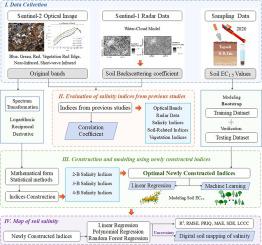Geoderma ( IF 5.6 ) Pub Date : 2022-05-20 , DOI: 10.1016/j.geoderma.2022.115935 Nan Wang , Jie Peng , Songchao Chen , Jingyi Huang , Hongyi Li , Asim Biswas , Yong He , Zhou Shi

|
Remote sensing indices have been proposed to characterize soil salinity. However, the sensitivity of these indicators is unstable owing to differences in geographic environment and vegetation type. This study investigated the performance of several existing indices to estimate the salinity of topsoil with residues in southern Xinjiang, China. The results showed that these indices were not satisfactory. In order to construct an index that can be used to directly indicate soil salinity in a specific area, novel salinity indices were calculated using optical bands (blue, green, red, vegetation red edge, and shortwave infrared bands) derived from Sentinel-2 multispectral data and Sentinel-1 radar data (backscattering coefficient VV, VH). To enhance the sensitivity of the optical bands, five transformation methods (logarithmic, reciprocal, first-, second-, and third-derivative) were applied to the original spectra. Based on previous studies, statistical methods were used to construct two-, three-, and four-bands indices. One constructed three-bands index with the second-derivative transformation, called the Enhanced Residues Soil Salinity Index (ERSSI), showed the highest correlation with topsoil salinity (r = 0.65 and 0.68 in training and testing). ERSSI establishes a linear relationship in soil salinity estimation with an R2 of 0.53 and a LCCC of 0.65 in training dataset, with an R2 of 0.51 and a LCCC of 0.73 in testing dataset. And it shows contribution in random forest regression with an R2 of 0.80 and a LCCC of 0.86 in training dataset, with an R2 of 0.77 and a LCCC of 0.81 in testing dataset. The ERSSI consisted of the B, G, and SWIR1 bands, and was sensitive to salinity variations in the residues remaining in farmland soils. This study provides a novel index and method for the accurate and robust assessment and mapping of salinity in farmland covered by crop residues.











































 京公网安备 11010802027423号
京公网安备 11010802027423号